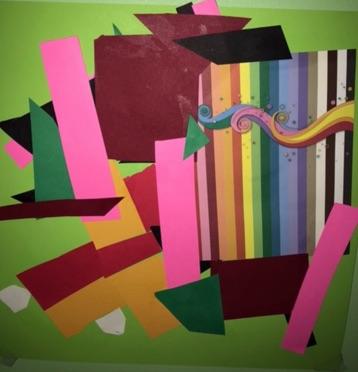Henri Matisse was always fascinated by colors. He spent many years painting with a paintbrush. But as he got older, he tried a new kind of art: the paper cut-out! To try something new, he took brightly painted papers, cut them into shapes, and arranged them in designs. Matisse called this “painting with scissors.”

Language
Look
What colors do you see? Find the same colors in different places throughout the artwork.
What shapes do you see? What do these shapes remind you of?
Do you see any lines in this work of art? Use your fingertip like a paintbrush to trace the lines in the air. What words would you use to describe the lines?
Where do we see these colors and shapes in nature?
How do you think Henri Matisse might have made this? What tools could he have used?
Read
Watch this video for a reading of "Henri's Scissors" by Jeanette Winter.

Books
Carmela Full of Wishes (Spanish language version: Los deseos de Carmela)
by Matt de la Peña and Christian Robinson
Carmela spends her birthday walking around her neighborhood with her brother, thinking about what to wish for herself and her family.
Henri’s Scissors (Spanish language version: Las tijeras de Matisse)
by Jeanette Winter
This book offers the story of Matisse's life, from his childhood to his old age, when he began to explore paper cut-outs.
Make: Paint With Scissors
Follow along with the video to try "painting" with scissors.

You Will Need
- Scissors
- Colored paper (or painted paper)
- Heavyweight white paper
- Glue sticks
Use colored paper or, like Henri Matisse, make your own colored paper by painting entire sheets of white paper in one color. Paint on heavyweight paper or cardstock so the paper doesn’t curl as it dries.
Next, think of a theme or place for your artwork, such as a garden, a city, or the sea. Use scissors to cut the colored paper into different shapes likes trees, buildings, or waves.
Arrange your cut-out shapes on a large piece of white paper. You can use the leftover pieces of colored paper too! Move the different pieces until you are happy with the design, then glue your shapes in place.
Vocab Bank
- cut-out
- design
- theme
Download
Art Tales: Coloring and Cut-Outs booklet (PDF, 3.5 MB)
Art Tales for Pre-K (PDF, 7.2 MB)
Primeros Pasos En El Arte (PDF, 7.5 MB)
Primeros Pasos En El Arte: Colorear y Recortes (PDF, 3.7 MB)
An Eye for Art: Henri Matisse teaching resource (PDF, 9.4 MB)
Visit
Register for the Art Tales pre-K school tour
Submit Student Work
Send images of your students' projects that follow these activities - email [email protected]
You may also like

Educational Resource: Art Starters: Joan Miró
A lesson for preschool to kindergarten students about artist Joan Miró’s painting The Farm. Students learn how to look at this painting, what you can read to learn more, how to create a collage, and a list of vocabulary terms related to this activity.

Educational Resource: Art Starters: Louise Bourgeois
A lesson for preschool to kindergarten students about artist Louise Bourgeois' sculpture Spider. Students learn how to look at this sculpture, what you can read to learn more, how to create your own symbolic sculpture, and a list of vocabulary terms related to this activity.

Educational Resource: Art Starters: Claude Monet
A lesson for preschool to kindergarten students about artist Claude Monet’s painting The Artist's Garden at Vétheuil. Students learn how to look at this painting, what you can read to learn more, how to draw a garden, and a list of vocabulary terms related to this activity.




